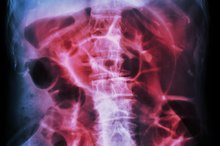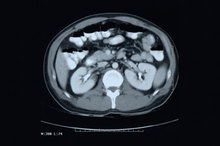Blocked Duodenum Symptoms
The duodenum is a portion of the small intestine and is responsible for absorbing nutrients from partially digested food and passing along the remainder to the rest of the intestinal system. In some cases, the duodenum can become blocked or obstructed, either due to an anatomical problem or from other structures impinging on the duodenum, resulting in a number of different symptoms.
Pain
One of the earliest signs of a blockage in the duodenum is pain in the abdomen. Initially the pain is intermittent, SmallBowelObstruction.net reports, and feels like abdominal cramping. Usually the pain centers around the perumbilical region, which is the area surrounding the navel. As the bowel obstruction progresses, the pain may increase in intensity and become constant; this suggests that strangulation has occurred, which means that blood flow to at least a portion of the duodenum has been stopped. Alternately, if the bowel stops contracting entirely, the pain may fade. Despite the loss of pain, this is quite serious, as it means that all movement through the duodenum has ceased.
- One of the earliest signs of a blockage in the duodenum is pain in the abdomen.
- As the bowel obstruction progresses, the pain may increase in intensity and become constant; this suggests that strangulation has occurred, which means that blood flow to at least a portion of the duodenum has been stopped.
Nausea and Vomiting
Distended Colon Symptoms
Learn More
Obstruction of the duodenum can also cause patients to become nauseated and vomit. In infants who are born with a congenitally blocked duodenum, this may be one of the few easily observable symptoms, the Pediatric Surgeons of Phoenix reports. When partially digested food becomes trapped in the duodenum, it can reflux back into the stomach, resulting in severe nausea and vomiting. Because the duodenum is the first portion of the small intestine, the vomit will be green in color due to the presence of bile.
- Obstruction of the duodenum can also cause patients to become nauseated and vomit.
- When partially digested food becomes trapped in the duodenum, it can reflux back into the stomach, resulting in severe nausea and vomiting.
Abdominal Distension
A blocked duodenum can also cause the abdomen to become distended, the Mayo Clinic states. Abdominal distension occurs because partially digested food builds up in the duodenum, stretching the walls of the small bowel and pressing on the surrounding tissue. If the blood flow to the duodenum is normal, the abdomen will not be tender; strangulation of the duodenum will cause the abdomen to be tender when pressed as well as swollen.
Bowel Palpitations
Emergency Symptoms of a Hernia
Learn More
The walls of the bowels contain muscles that are responsible for peristalsis, which is a series of rhythmic contractions that force solid and liquids through the intestines. Patients with an obstructed duodenum may develop very rapid peristaltic contractions, which can make it feel like there are palpitations within the bowels, according to The Merck Manuals Online Medical Library.
Changes in Bowel Movements
A blocked duodenum can also alter the frequency of bowel movements. If the duodenum is only partially blocked, diarrhea may result, as liquid material is able to pass through more easily. Complete obstruction can result in constipation as well as the inability to pass gas.
Related Articles
References
- The Merck Manuals Online Medical Library: Intestinal Obstruction
- Pediatric Surgeons of Phoenix: Duodenal Atresia
- Mayo Clinic: Small Bowel Obstruction
- Small Bowel Obstruction: Symptoms
- Collins J, Badireddy M. Anatomy, abdomen and pelvis, small intestine. StatPearls. Updated April 5, 2019.
- U.S. Department of Health and Human Services. National Institutes of Health. Duodenal atresia. Updated 2018.
- Iron Disorders Institute. Absorption. Updated January 1, 2020.
- Mailhe M, Ricaboni D, Vitton V, et al. Repertoire of the gut microbiota from stomach to colon using culturomics and next-generation sequencing. BMC Microbiol. 2018;18(1):157. doi:10.1186/s12866-018-1304-7
- MUSC Health. Stomach and duodenum. Updated 2019.
- Murray JA, Rashtak S, Rubio-tapia A. Diagnosis of celiac disease in pediatric patients. Nat Rev Gastroenterol Hepatol. 2009;6(5):260-2. doi:10.1038/nrgastro.2009.58
- Owen DR, Owen DA. Celiac disease and other causes of duodenitis. Arch Pathol Lab Med. 2018;142(1):35-43. doi:10.5858/arpa.2016-0608-RA
Writer Bio
Adam Cloe has been published in various scientific journals, including the "Journal of Biochemistry." He is currently a pathology resident at the University of Chicago. Cloe holds a Bachelor of Arts in biochemistry from Boston University, a M.D. from the University of Chicago and a Ph.D. in pathology from the University of Chicago.









